More than 100 international scientists and engineers converged at the Hilton University of Houston from April 3 through April 6 to attend the biennial Coated Conductors for Applications International Workshop (CCA 2023).
For a photo gallery from the event, check out this album on our Flickr account!
Leading industries, national laboratories, universities, and government agencies were represented by participants, who presented 65 different papers at the meeting.
Venkat Selvamanickam, CCA Chairman and the M.D. Anderson Chair Professor of Mechanical Engineering at the University of Houston's Cullen College of Engineering, said it had been nearly five years since the workshop was hosted in person in Vienna.
"In the last five years, the demand for coated conductors has skyrocketed because of the new field of compact fusion," he said. "CCA 2023 emphasizes the applications side of coated conductors – compact fusion, magnetic applications and power applications.”
Coated conductors are long tapes (like an electrical tape) where a thin superconductor film made of rare-earth-barium-copper-oxide (REBCO) is coated on a metal substrate. The superconductor tape is wound in the form of a coil or a cable for use in magnetic applications and electric power applications. Coated conductors have performance that far surpasses conventional superconducting materials and enable applications in much higher magnetic fields and temperatures, such as compact fusion, particle accelerators, healthcare, electric aviation, wind generators, power transmission cables and more.
It was a fitting tribute that the international workshop, which rotates biennially between Europe, Asia, and the U.S., met at the University of Houston - the birthplace of YBCO (Yttrium Barium Copper Oxide), discovered by Paul Chu's group 35 years ago and where superconductivity is still flourishing. The yttrium-barium-copper oxide compound was the first high temperature superconductor to raise the transition temperature to 92 K, which was important because cheap and readily available liquid nitrogen could then be used as a refrigerant. (At atmospheric pressure, the boiling point of nitrogen is 77 K.)
Three plenary talks outlined important progress made in high-impact areas. Rod Bateman of Tokamak Energy in the United Kingdom, discussed the development of coated conductor-based magnets for spherical Tokamaks. Mark Bird of the National High Magnetic Field Laboratory at Florida State University reviewed the latest high magnetic field applications for coated conductors. Alexandre Colle of Airbus UpNext in France outlined the ASCEND: cryogenic and superconducting powertrain for the propulsion of electric aircraft.
A conductor manufacturing session highlighted the world’s six major manufacturers of coated conductors. A conductor research session focused on progress towards meeting applications requirements, and a separate session on electromagnetic and electromechanical properties was held. Sessions on magnetic and power applications of coated conductors rounded out the workshop.
At a special dinner tribute to celebrate their collective 80th birthdays, three pioneers in the field were honored for their trailblazing efforts to create and nurture programs designed to advance superconductor technologies.
Professor Paul C. W. Chu, founding director and chief scientist of the Texas Center for Superconductivity at the University of Houston, was lauded for his discovery of YBCO and continued development of new materials.
Professor Herbert C. Freyhardt, University Professor, Georg-August Universitaet Goettingen (ret.) and former Research Professor of Mechanical Engineering and Texas Center for Superconductivity at the University of Houston, was honored for creating the CCA workshop and the EUCAS (European Conference on Applied Superconductivity) conference, and for his tireless efforts for the Superconductivity News Forum, CEC-ICMC, IEEE-CSC, and other organizations.
Professor David C. Larbalestier, Chief Materials Scientist of the National High Magnetic Field Laboratory and Krafft Professor in the Department of Mechanical Engineering at Florida State University, was recognized for his contributions in high magnetic applications of coated conductors.
Given that workforce needs for the superconductor industry have skyrocketed, the workshop attracted students and early career professionals to connect with potential employers. The CCA Poster Prize competition was inaugurated, and five students and young professionals were awarded certificates and cash prizes for their work.
Nathaly Castaneda Quintero of the University of Houston (UH) won first prize for her work on 2D reel-to-reel scanning Raman spectroscopy of REBCO conductor for quality control.
Two second prizes were presented to Siwei Chen, Ph.D., and Chirag Goel. Chen's work on quality assessment of long REBCO coated conductors by offline/inline characterization techniques augmented by machine-learning models was conducted while at UH. Chirag Goel, Ph.D. Research Assistant in Mechanical Engineering since August 2021, presented his work on superior critical current of long-length, 4-μm-thick film REBCO tapes.
Two third prizes were awarded to John Rogers of Texas A&M University and Accelerator Corporation and Takanobu Mato of the National High Magnetic Field Laboratory in Florida.
Members of the CCA International Steering Committee, Scientific Program Committee, and Local Committee were joined by Platinum sponsor Faraday Factory Japan, and Gold sponsors IEEE Council on Superconductivity (IEEE-CSC), MetOx, and SuNAM to ensure that the three-day event was a success. University of Houston Gold sponsors included the Cullen College of Engineering, the Advanced Manufacturing Institute (AMI), the Texas Center for Superconductivity at the University of Houston (TcSUH), and the Hewlett Packard Enterprise Data Science Institute. A private donor also provided generous support.

![Two participants chat during CCA 2023. For more images, please check out our Flickr gallery [link provided in story]. Two participants chat during CCA 2023. For more images, please check out our Flickr gallery [link provided in story].](/sites/ccoe.egr.uh.edu/files/images/news/2023/cca-participants-chatting-01.jpg)